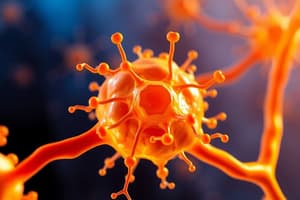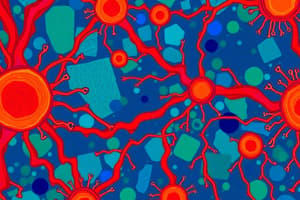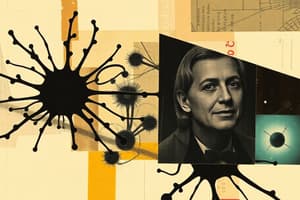Podcast
Questions and Answers
What is one of the major functions of cell surface receptors?
What is one of the major functions of cell surface receptors?
- Suppression of gene expression
- Deactivation of intracellular signaling
- Internalization of extracellular molecules (correct)
- Inhibition of cell adhesion
Which process typically initiates signal transduction from a cell surface receptor?
Which process typically initiates signal transduction from a cell surface receptor?
- Inhibition of ligand binding
- Endocytosis of the receptor
- Degradation of receptor proteins
- Phosphorylation of amino acids (correct)
How does ligand-induced clustering of receptor proteins affect signal transduction?
How does ligand-induced clustering of receptor proteins affect signal transduction?
- It prevents extracellular ligand attachment.
- It leads to receptor cross-linking. (correct)
- It promotes receptor degradation.
- It inhibits cytosolic signaling.
What role do transcription factors play in the process initiated by cell surface receptors?
What role do transcription factors play in the process initiated by cell surface receptors?
Which type of receptors require lipid soluble ligands for activation?
Which type of receptors require lipid soluble ligands for activation?
What is the function of protein kinases in signal transduction?
What is the function of protein kinases in signal transduction?
What is a key feature of receptor tyrosine kinases (RTKs)?
What is a key feature of receptor tyrosine kinases (RTKs)?
Which type of receptor participates in receptor activation through non-receptor tyrosine kinases?
Which type of receptor participates in receptor activation through non-receptor tyrosine kinases?
What is the role of G protein-coupled receptors (GPCRs)?
What is the role of G protein-coupled receptors (GPCRs)?
What distinguishes nuclear receptors from other receptor types?
What distinguishes nuclear receptors from other receptor types?
How do receptors of the Notch family contribute to lymphocyte development?
How do receptors of the Notch family contribute to lymphocyte development?
What process is triggered when a ligand binds to a GPCR?
What process is triggered when a ligand binds to a GPCR?
Which of the following is NOT a function associated with nuclear receptors?
Which of the following is NOT a function associated with nuclear receptors?
What common feature is shared by G protein-coupled receptors and receptor tyrosine kinases?
What common feature is shared by G protein-coupled receptors and receptor tyrosine kinases?
What role do the hypervariable regions, or complementarity-determining regions (CDRs), play in TCR functionality?
What role do the hypervariable regions, or complementarity-determining regions (CDRs), play in TCR functionality?
Which statement accurately describes the interaction of CD4 and CD8 with MHC molecules?
Which statement accurately describes the interaction of CD4 and CD8 with MHC molecules?
How are CD8 molecules typically structured?
How are CD8 molecules typically structured?
What is the significance of the immune synapse in T cell activation?
What is the significance of the immune synapse in T cell activation?
Which of the following statements is true regarding the expression of CD4 and CD8 on mature αβ T cells?
Which of the following statements is true regarding the expression of CD4 and CD8 on mature αβ T cells?
What structural features are characteristic of the CD4 molecule?
What structural features are characteristic of the CD4 molecule?
What is the role of non-receptor tyrosine kinases in cellular receptors?
What is the role of non-receptor tyrosine kinases in cellular receptors?
What distinguishes receptor tyrosine kinases from non-receptor tyrosine kinases?
What distinguishes receptor tyrosine kinases from non-receptor tyrosine kinases?
What type of ligands do nuclear receptors bind to in order to function as transcription factors?
What type of ligands do nuclear receptors bind to in order to function as transcription factors?
What is a characteristic feature of immune receptors like T cell receptors (TCRs)?
What is a characteristic feature of immune receptors like T cell receptors (TCRs)?
Which receptor is known to have an immunotyrosine-based 'switch' motif in its cytoplasmic tail?
Which receptor is known to have an immunotyrosine-based 'switch' motif in its cytoplasmic tail?
What is the configuration of the T cell receptor (TCR) for antigen?
What is the configuration of the T cell receptor (TCR) for antigen?
What is the function of ITIM motifs found on some inhibitory receptors?
What is the function of ITIM motifs found on some inhibitory receptors?
How do receptor tyrosine kinases typically become activated?
How do receptor tyrosine kinases typically become activated?
Which of the following receptors specifically contains ITAMs?
Which of the following receptors specifically contains ITAMs?
What is formed by the Vβ and Vα domains of the T cell receptor?
What is formed by the Vβ and Vα domains of the T cell receptor?
Flashcards are hidden until you start studying
Study Notes
Cell Surface Receptor
- Cell surface receptors are involved in various functions including signal transduction, cellular adhesion, and internalization of extracellular molecules and cells.
- Receptors initiate signaling, often involving an initial cytoplasmic phase where the receptor or interacting proteins are modified.
- This may result in the activation or nuclear translocation of transcription factors, followed by a nuclear phase where these factors orchestrate gene expression changes.
Signal Transduction
- Also known as intracellular signaling pathways.
- Initiated by receptors on the plasma membrane, recognizing soluble ligands or structures on neighboring cells or the extracellular matrix.
- Nuclear receptors, activated by lipid-soluble ligands, are found intracellularly.
- Ligand binding to a receptor may induce clustering (cross-linking) or conformational changes.
Phosphorylation in Signal Transduction
- A common early event in signal transduction is the addition of a phosphate group to tyrosine, serine, or threonine residues in the receptor or adaptor proteins, by protein kinases.
- For example, protein tyrosine kinase phosphorylates specific tyrosine residues.
Categories of Cellular Receptors
- Non-receptor tyrosine kinases: These receptors lack intrinsic catalytic activity but rely on a separate intracellular tyrosine kinase to activate them by phosphorylating specific motifs on the receptor or associated proteins.
- Receptor tyrosine kinases (RTKs): Integral membrane proteins with an intrinsic tyrosine kinase domain in their cytoplasmic tails, activated upon cross-linking by multivalent extracellular ligands.
- Nuclear receptors: Primarily located in or migrate to the nucleus, acting as transcription factors. Examples include vitamin D receptor and glucocorticoid receptor, influencing processes like immune system development and cytokine gene regulation.
- G protein–coupled receptors (GPCRs): Activate associated GTP-binding proteins (G proteins). Ligand binding induces a conformational change, enabling the activation of a heterotrimeric G protein by exchanging GDP with GTP. Relevant examples in immunity and inflammation include receptors for leukotrienes, prostaglandins, histamine, complement fragments C3a and C5a, and chemokines.
- Receptor proteins of the Notch family: Involved in development across species. Ligand binding triggers proteolytic cleavage of the receptor and nuclear translocation of the cleaved cytoplasmic domain (intracellular Notch), functioning as a component of a transcription complex. Contribute to cell fate determination in lymphocyte development and may influence the activation of mature lymphocytes.
Immune Receptor Family
- Immune receptors that activate immune cells have separate chains for recognition and associated chains containing cytosolic Immunoreceptor tyrosine-based activation motifs (ITAMs).
- The B cell receptor (BCR), T cell receptor (TCR), and high-affinity receptor for IgE (FcεRI) contain ITAM motifs.
- Inhibitory receptors in the immune system typically have ITIM motifs in their cytoplasmic tails, involved in ligand recognition.
- FcγRIIB is an inhibitory receptor found on B cells and myeloid cells. PD-1, an inhibitory receptor found on T cells, also has an immunotyrosine-based “switch” motif in its cytoplasmic tail.
T Cell Receptor for Antigen
- The antigen receptor on MHC-restricted CD4+ helper T cells and CD8+ cytotoxic T lymphocytes (CTLs) is a heterodimer composed of two transmembrane polypeptide chains, TCR α and β, linked by a disulfide bridge.
- The antigen-binding portion is formed by the Vβ and Vα domains.
- The hypervariable segment loops forming the peptide- MHC binding site are located at the top.
Binding of TCR to an MHC molecule
- The V regions of the TCR α and β chains contain hypervariable or complementarity-determining regions (CDRs) responsible for specific recognition of peptide-MHC complexes.
Components of the TCR Complex
- CD4 and CD8 are T cell coreceptors binding to nonpolymorphic regions of MHC molecules, facilitating TCR complex signaling during T cell activation.
- Mature αβ T cells express either CD4 or CD8, not both.
- CD8 interacts with class I MHC molecules, while CD4 interacts with class II MHC molecules, defining the class I or class II MHC restriction of these T cell types.
Role of the CD4 and CD8 Coreceptors in T Cell Activation
- CD4 has four extracellular Ig-like domains, a hydrophobic transmembrane region, and a cytoplasmic tail with 38 amino acids.
- CD4's two N-terminal Ig-like domains bind to the nonpolymorphic α2 and β2 domains of the class II MHC molecule.
- CD8 molecules typically exist as heterodimers of two chains, CD8α and CD8β, each with a single extracellular Ig domain, a hydrophobic transmembrane region, and a cytoplasmic tail with 25 amino acids.
The Immune Synapse
- A stable contact between an antigen-specific T cell and an APC presenting that antigen.
- Serves as a site for assembling the T cell's signaling machinery, including the TCR complex, coreceptors, costimulatory receptors, and adaptors.
- Facilitates prolonged and effective T cell signaling, ensuring specific delivery of secretory granules and cytokines from the T cell to APCs or targets.
- May also be a site for the turnover of signaling molecules, contributing to the termination of T cell activation.
Signal Transduction
- Phosphorylation of proteins and lipids plays a crucial role in TCR complex and coreceptor signal transduction.
- There is basal tyrosine phosphorylation of ITAM tyrosines and some recruitment of ZAP-70 even before TCR activation.
- Within seconds of TCR ligation, Lck phosphorylates the ITAMs of the CD3 and ζ chains.
Calcium- and Protein Kinase C-Mediated Signaling Pathways in T Lymphocytes
- The TCR complex, upon interaction with peptide-MHC complexes, triggers a series of intracellular signaling events.
Activation of Transcription Factors That Regulate T Cell Gene Expression
- Different transcription factors are activated by distinct cytoplasmic signal transduction pathways.
- Multiple transcription factors are required for activating numerous signaling pathways after antigen recognition, including those encoding cytokine receptors and effector molecules.
- Key transcription factors activated in T cells by antigen recognition include nuclear factor of activated T cells (NFAT), AP-1, and NF-κB, crucial for most T cell responses.
Studying That Suits You
Use AI to generate personalized quizzes and flashcards to suit your learning preferences.




